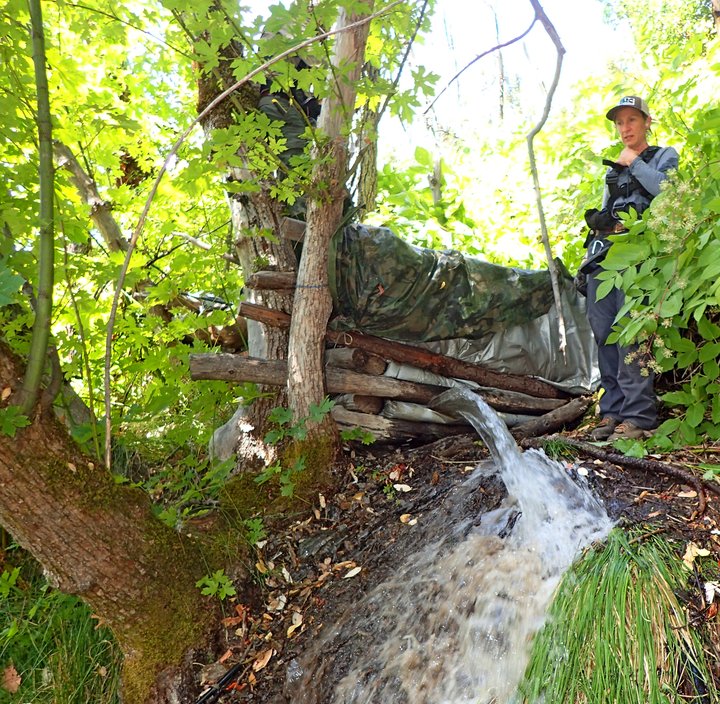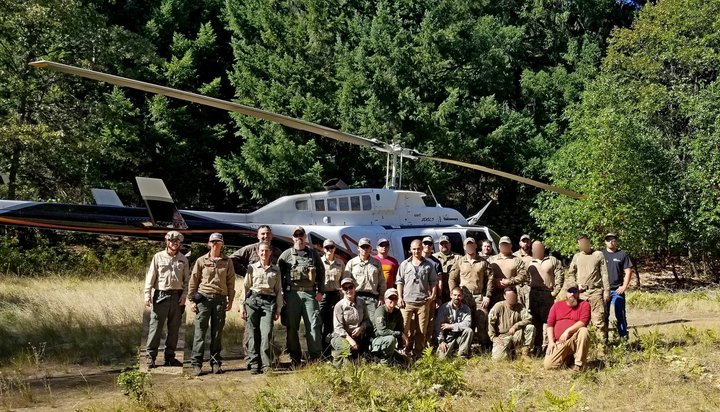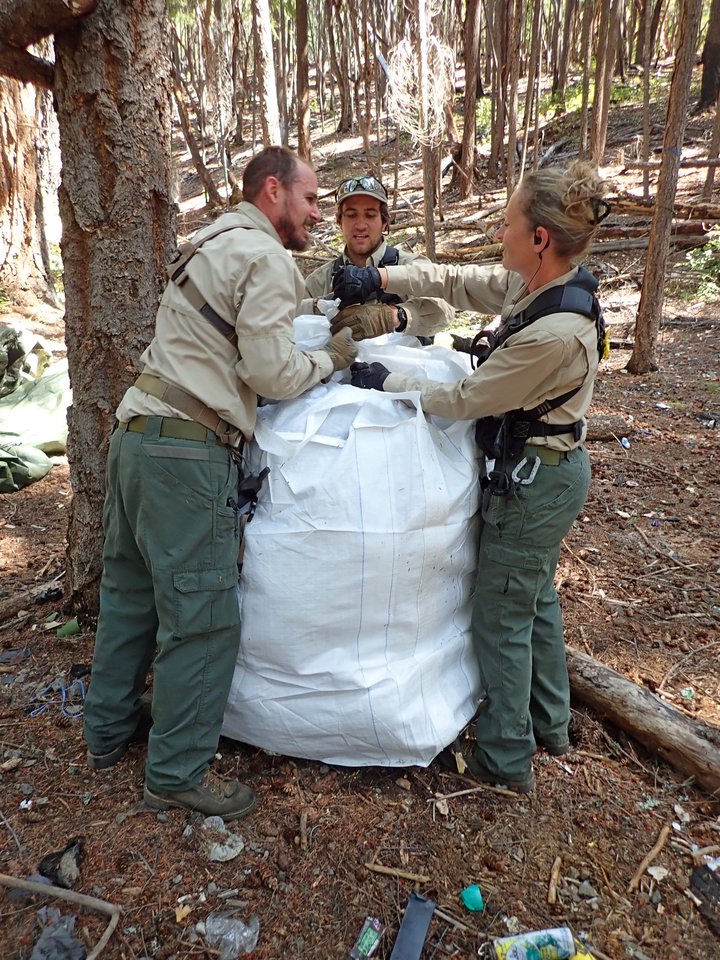A panorama view of a campsite at a trespass cannabis cultivation complex in the Trinity Alps Wilderness. Credit: IERC
Press release from Blue Lake’s Integral Ecology Research Center:
This week marks the 55th anniversary of the Wilderness Act, which was passed by the 88th Congress and signed by President Lyndon Johnson on September 3, 1964. Under this Act, the National Wilderness Preservation System was established to protect designated wilderness areas that federal land agencies are tasked with managing. Unfortunately, clandestine cannabis cultivation on federally designated wilderness areas protected under the Wilderness Act is common. Drug trafficking organizations use these pristine lands to cultivate cannabis with destructive methods where they divert water from protected salmon streams, remove forest structure essential for wildlife, and pose hazards to recreationists while abusing these unspoiled lands.
The Trinity Alps Wilderness was designated by the 98th Congress in 1984, and the United States Forest Service is responsible for its management. This wilderness provides refugia for threatened flora and fauna, including northern spotted owls, coho and chinook salmon, Pacific tailed frog, Pacific fishers, and Humboldt martens.
In celebration of this anniversary and to respect the framework and goals of the Act, we at Integral Ecology Research Center (IERC) and our partners set out to reduce negative human impacts and remove hazards to threatened and endangered species on the undeveloped, natural lands of the Trinity Alps Wilderness. A seven-day operation named Operation Wild Fisher in this wilderness was completed in which non-profits alongside United States Forest Service Law Enforcement and Fire, California Army National Guard, and local resource agencies tirelessly cleaned up trespass cannabis cultivation complexes (TCCC). During Operation Wild Fisher, an interdisciplinary partnership of highly qualified teams cleaned up a total of nine expansive cultivation complexes including the removal of water diversions, food and cultivation refuse, and toxicants that pose considerable threats to fish, wildlife and humans. Collectively, over 7,000 pounds of trash and 8 miles of irrigation line were removed from this wilderness, some of which was hauled from over 5 miles into the wilderness. This effort marked the first time that more trespass cannabis complexes were removed from this wilderness setting than were established for the year. Operation Wild Fisher was a model for future efforts where qualified and diverse groups join forces and work collaboratively towards a focused goal aimed at removing the stranglehold trespass cannabis cultivation has on our wilderness areas. Please see the below list of operational statistics as well as all those involved that were instrumental for Operation Wild Fisher’s success.
Cordially,
Dr. Mourad Gabriel and Dr. Greta Wengert, Co-Directors of IERC
###
Operation Wild Fisher: Reclamation of Cannabis Cultivation Complexes
Shasta – Trinity National Forest: Trinity Alps Wilderness AreaOperation Synopsis and Statistics
August 22 – August 30, 2019Organizations Involved
Governmental: United States Forest Service Law Enforcement and Investigations (USFS-LEI), USFS Fire and Investigations, Trinity County Resource Conservation District (TCRCD) and California National Guard Counterdrug Task Force (CNG-CDTF)
Non-Governmental: Integral Ecology Research Center (IERC), Watershed Research and Training Center (WRTC),
Reclamation Organizers: Dr. Mourad Gabriel, Dr. Greta Wengert, Ivan Medel (IERC); Captain Chris Magallon, Officer Logan Brown (USFS-LEI)
Funding Support: Funding for the reclamation of these trespass cannabis cultivation complexes was provided by United Stated Forest Service Law Enforcement and Investigations and a California Department of Fish and Wildlife Cannabis Restoration Grant to Integral Ecology Research Center.
Logistical Support: The United Stated Forest Service Law Enforcement and Investigations and California National Guard Counterdrug Task Force assisted with coordination and provided law enforcement officers and vehicles as a force multiplier for this effort. The US Forest Service Exclusive Use helicopter was provided as the aerial asset for the entire operation.
Statistics
Number of cannabis complexes reclaimed: Nine (9)
Total number of independent sites reclaimed: Twelve (12)
Location: Shasta – Trinity National Forest, Trinity Alps Wilderness
Watersheds affected: Big French Creek, Little French Creek, Big Creek, and Devil’s Canyon, all draining into the Trinity River
Species of conservation concern affected: northern spotted owl, Pacific fisher, Humboldt marten, Pacific tailed frog, foothill yellow-legged frog, and salmon.
Personnel: IERC (8), USFS-LEI (12), WRTC (8), CNG-CDTF (5), TCRCD (3)
Trash and infrastructure removed during reclamation: 7,560 lbs (3.78 tons)
Irrigation pipe removed during reclamation: 8.24 miles (43,520 ft)

Before and after photos of refuse removal at campsite at a trespass cannabis cultivation complex in the Trinity Alps Wilderness. Credit: IERC

An active water diversion being dismantled at a trespass cannabis cultivation plot in the Trinity Alps Wilderness. Credit: IERC

A team of IERC scientists hauling out a bag load of trash from a campsite . Credit: IERC

A reclamation team heading out to start a clean up at a trespass cannabis cultivation site in the Trinity Alps Wilderness. Credit: IERC

Partnerships in action . Credit: IERC

A team of IERC scientists packing a bag load of trash from a campsite. Credit: IERC

Irrigation line being collected from a trespass cannabis cultivation plot in the Trinity Alps Wilderness. Credit: IERC
CLICK TO MANAGE